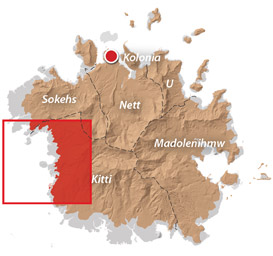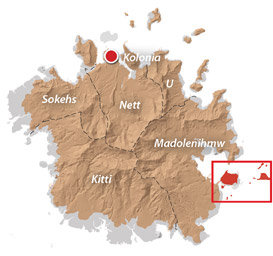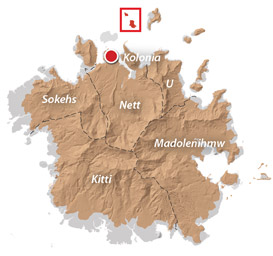The Fortress of Sapwtakai
Sapwtakai (“rock land”) is a 13,000 m2 stone complex that crowns a hill north of Wenik. The site was first occupied around 1250 A.D. and functioned as a political center for at least four centuries. The walls, terrace platforms, stone-paved walkways, tombs, and other features were built in three phases. The upper portion of the fortress was the residential area, while the southern part was the ceremonial center.
The wall on the north side of Sapwtakai is higher than at other points — presumably to deter enemies from that direction, while the steep slope on the east side offers natural protection. About 15 meters north of the complex perimeter is another free-standing 1.5 to 2 meter high wall that runs south and east. These defensive structures failed, however, to protect the fortress from incursions by the Dipwinpehpe clan, which took control of Pehleng and then moved south, driving out the Soukitti clan and conquering Sapwtakai. The fortress was occupied for a period of time, during which the Dipwinpehpe destroyed some of its features. Neighboring Onohnleng eventually decided that the need to regain power over the region justified open war. The main force of warriors were sent marching north from Lukoap. At the same time, a fleet of canoes was assembled off the coast. But instead of containing more fighting men, the canoes carried dummies. The Dipwinpehpe saw what Onohnleng wanted them to — two separate forces set against them. They divided their own army to deal with both the men on land and the fleet, only to find that they’d been tricked. The divided army was soon defeated by the men of Onohnleng, Sapwtakai was retaken, and the regions that now make up Kitti were united under centralized leadership for the first time.
Sapwtakai continued to be utilized for some time after the unification of Kitti, but was abandoned around 1850. Other than a meticulous archaeological survey by Joyce Bath in 1980, the ruin has mostly been left to time and nature — rarely visited and entirely unmanaged by Pohnpei State and the Historic Preservation Office. A lot of the hill has been overgrown by wild hibiscus, durien, and hellishly stickery wild yam vines with spines that will go right through the soles of booties or FiveFingers. There is still much to see, but it’s imperative that one finds a good guide who knows the site well.
Points of interest include boulder walls as tall as 2 meters beyond the northern perimeter, a platform of tabular basalt in the northern corner that rises 2 meters above the wall, several 450-year-old house platforms with central fire pits, breadfruit storage pits, a large burial complex constructed of basalt boulders and prisms and containing two openings leading to a central crypt, a contemporary Japanese slit trench, a 2-tiered platform with a central fire pit where hammer stones for pounding sakau were discovered, and seven river cobbles that are said to be magical sling stones.
“Kitti Rock” Area Ruins
The cluster of ruins on the slope below Sapwtakai were referred to as “Kitti Rock” by archaeologists because a basalt stone from Nan Madol was placed in the area when Kitti was founded. There are many sites. We’ve highlighted only a few here.
Dolomar Paiei (Site 35-26)
This is a two-tiered stone platform in Sapwtakai district with terraces on two sides.
Dolomar Pailong (Site 35-14)
This is a stone platform southwest of the Sapwtakai ruins.
Peidolenmai (Site 32-8)
Peidolenmai (“stone platform of the hill of breadfruit”) is a 3 x 4.5 meter stone platform in Alauso with two breadfruit storage pits inside the enclosure. The pits and the name indicate the purpose of the site.
Peinkareraua (Site 35-17)
Peinkareraua is a stone platform with an enclosing wall 2 meters thick and two low platforms that together formed the residence of the ruler of Kepihleng and the center of state ceremonial events, located southwest of Sapwtakai ruins in Sapwtakai district.
There are many access points for these ruins. It’s possible to cut southwest from Sapwtakai and find oneself in the midst of the highest concentration of the “Kitti Rock” sites, but trails also run from Nanmand, Marahu, and Seinwar. Ask around for guides at houses in those areas.
Diadi & Wenik Sites
“Dolen Samaki” (Site 30-18)
This is a stone enclosure on an 86 meter hill in Wenik district, identified by the name of the hill on which it is found. At the site is a huge magical boulder (takai wek mai) that was used in combination with a spell to ensure a good breadfruit harvest. There are also three other large boulders with special properties. The site is mentioned in the oral history of Utin Iap, the “banana of Yap”.
Pahn Kipar (Site 30-19)
Pahn Kipar is a 5 x 6 meter stone terrace platform with an extended breadfruit storage pit in Wenik district.
Peinmwas (Site 30-20)
Peinmwas (“stone platform of the worm”) is a stone platform, now mostly buried or scattered, between Wenik and Diadi districts. The site is mentioned in the Utin Iap (“banana of Yap”) oral history.
Pohn Kohla (Site 27-3)
This 13 x 15 meter rock platform and stone-paved terrace is located between Wenik and Diadi districts on the southern slope of a hill. The location has two peitehl (sakau stones) and an uhmw (rock oven) site.
The most direct access point for these sites is at Oare, but it’s also possible to reach them via trails beginning opposite the Kitti SDA Church. Ask around for guides at houses and stores in either of these locations.
Seinwar Area Sites
Niahlek (Site 34-29)
This is a single 5 x 6 meter stone platform with a central pit located in Seinwar district.
Soaid (Site 34-32)
This stone burial platform is found in Seinwar district on the hillside above the Circle Island Road.
It’s possible to find people in Seinwar who can lead visitors southeast past Soaid, Niahlek, and other sites in this vicinity. Ask around at houses and stores along the main road.
Pan Pei, Alauso, Poatoapoat & Wenik Area Sites
Narong (Site 31-17)
This is a semi-circular stone terrace platform with a large shell midden, where a number of artifacts — including a breadfruit pounding stone, hammer stone, and coral grinding stone used to make breadfruit peelers from cowrie shells — were found. Breadfruit was prepared at this place for preservation in pits. The site is located in Poatopoat district.
Pan Pei
About 680 meters southwest of Sapwtakai and 400 meters northeast of the Kitti Municipal Office are the structures of Pan Pei. The primary feature in the group is a 169 m2 burial platform built of prismatic basalt columns and containing four crypts. The platform is about 1 meter high. At one point in the past the crypts were roofed with columns. A road 25 meters south of the Municipal Office leads up into the hills, passing several of the Poatoapoat sites and connecting with a footpath that runs north to the Pan Pei sites before ending at a residence. From the residence, another footpath goes southeast to the top of a hill where the Japanese had an anti-aircraft gun installed (the gun is not there now).
“Pilen Koaroan” (Site 35-19)
“Pilen Koaroan” consists of three stone structures, including a double vault tomb attached to a wall and a stepped platform with a central pit. It’s part of the “Pan Pei” group.
“Diadi” (Site 30-16)
This is a single 9 x 11 meter stone platform surrounded by a wall and identified by the name of the district in which it lies. The area is marshy. The wall ranges from a half meter to a meter in height and has a single entrance about a meter wide, while the central pit is little less than a square meter and a third of a meter deep. “Diadi” is also unique because the walls consist of boulders, flat stones, and oblong basalt prisms mixed together.
Site 30-17
This is a stone ruin in Diadi district just below the peak of a hill and nearby the “Diadi” ruin.
For these sites, ask at and around the Kitti Municipal Office for a guide.
Salapwuk Area Sites
Elen Eni
Elen Eni (“ghost path”) is the sacred burial site of a number of traditional high priests, called soumw. These priests were instrumental in the religious cult that thrived in Salapwuk prior to the conquest of Christian missionaries. Many Pohnpeians are afraid of the site and would never go there or consider taking a foreigner there, but there are some guides who would be willing to make a visit if certain ground-rules are followed.
Lehn Mwahmw
Lehn Mwahmw (“fish pool”) is a natural pool on the Lehnmesi River rather than a man-made site. Located in Salapwuk district, the pool is believed to be a spot that Pohnpei’s early settlers stocked with fish upon arrival.
Lehnpoudek
Lehnpoudek (“mooring pool”) is another natural pool on the Lehnmesi. Myth suggests that Pohnpei’s founder, Sapwkini, and his entourage moored their canoes at this spot.
“Rasalap” (Site 24-7)
This is a 10 x 14 meter stone complex (141 m2), consisting of boulders stacked to form two low platforms separated by a wall and enclosed in a meter high perimeter wall. Once again, the name actually refers to the area — a huge, marshy savannah and fern meadow on a hill west of Salapwuk district — rather than to the structure itself. The most unusual aspect of the site is the dual courtyards — a feature atypical in prehistoric Pohnpeian architecture. The site’s purpose is not clear.
Sokosoken Leng
In the forest off the west side of the road past Salapwuk Elementary School is a basalt boulder with a coralhead on top. Sokosoken Leng (“landing of heaven”) and its stone marks the spot where Pohnpei’s mythical founder, Sapwkini, first docked his voyaging canoe and later began to build Pohnpei on the reef, using magic to pile up rocks and earth to form an island.
Takain Pwohng
Takain Pwohng (“stone of night”) is a trio of boulders along the Lehnmesi River, where one high priest (soumw) of the Salapwuk religious cult was said to have lived in ancient times, allegedly performing human sacrifices and ritual cannibalism at a small cave under the largest rock.
The best point of contact for the Salapwuk sites is Welten Panuel. If Welten cannot take you himself, he will be able to recommend a guide for most or all of the Salapwuk area sites. Visit the Guides & Tour Operators page for contact info.




